
Map: Iceland’s Tectonic Plates
Gazing into a volcanic crater lake, leaping across a tectonic fissure in the earth’s crust, or following a track across a lava field are among the experiences you can have in Iceland. Not to mention descending into the underground magma chamber of an extinct volcano, or boiling an egg in the ashes of a new one. Explore waterfalls, glaciers, geysers, rivers, fjords, and cliffs. The surrounding ocean teems with giant whales and adorable puffins. Or you could luxuriate in an outdoor bath filled with earth-warmed water.
Iceland is a small land that packs in a lot of experiences—and there are things you can do here that you can’t do anywhere else (not easily, at least). This chapter is a rundown of some of the quintessential Icelandic experiences, designed to inspire your trip planning and point you to more thorough coverage elsewhere in this book.
Even with a car—and especially without—many of these experiences require going through a tour operator. I’ve listed some established outfits. But the scene changes frequently, so check online to see if newer variations on these experiences now exist (for instance, the “Things to Do” reviews on TripAdvisor can offer a helpful roundup).
A good one-stop resource is Guide to Iceland, a for-profit consolidator of travel providers that works in partnership with the Reykjavík TI. Guide to Iceland has a desk in Reykjavík’s City Hall that can explain the offerings of many different companies—allowing you to comparison-shop easily in person—or you can search their website (www.guidetoiceland.is), which also hosts many evocative blogs. They charge no additional commission and will match a better price if you find one. They work with some, but not all, tour providers in Iceland, so it’s smart to also do your own research.
Note that while Reykjavík is usually a good home base, many excursions head to destinations quite far away—which means long hours in a bus and higher prices. Staying closer to your objective and booking a tour that originates nearby may be a better option. For example, if you’re interested in glacier activities, consider spending a night or two on the South Coast or in Southeast Iceland.
As you join the hordes of international visitors who treat Iceland as a newly discovered playground, do so considerately. Respect the land. The nature on display may seem raw and powerful, but it’s also extremely fragile. Nobody yet knows precisely what long-term impact the recent influx of tourism will have on this special place. To be part of a sustainable long-term prosperity, treat Iceland as a precious treasure...because that’s what it is.
More than one-tenth of Iceland’s surface is covered with glaciers (jökull)—mainly along the southern coastline and in the desolate interior. The glaciers are most accessible at so-called tongues, where a slow-motion river of ice flows down a valley.

There are several accessible glacier tongues along Iceland’s southern coast, from near Skógar in the west to near Höfn in the east. If traveling on your own, you can hike close to the tongue of a glacier in two places: at the Skaftafell wilderness area, where you can walk to a branch of Iceland’s largest glacier, Vatnajökull (see here); or at Sólheimajökull, along the southern coast closer to Reykjavík (here).
There are also two glacier lagoons—where a glacier tongue terminates in a beautiful pool of water, and icebergs calve off and float around—a few minutes’ drive apart in Southeast Iceland: Jökulsárlón and Fjallsárlón. At either, you can pull over for a good look at the lagoon, or pay to board a boat for an up-close trip between bobbing icebergs. Near Jökulsárlón is another enchanting glacial sight, the so-called Diamond Beach, where chunks of shimmering ice from the nearby lagoon wash up on a black sand beach. This is a magical look at the final stage of glacial ice’s very long, very slow journey to the open ocean. (For more on all three of these sights, see here).
For safety’s sake, the activities described above are the only glacier-related ones you should attempt on your own. Properly outfitted and with a guide, you have more options.
Several companies offer glacier walks. They’ll equip you with cold-weather gear, serious crampons, and ice axes, then tie your group together and carefully amble across the ice. The most popular places for this are Sólheimajökull and Skaftafell in Southeast Iceland. The two big tour companies—Reykjavík Excursions and Gray Line—offer this, as do as a variety of smaller, more specialized operators, including Icelandic Mountain Guides (www.mountainguides.is), Arctic Adventures (www.adventures.is), Troll Expeditions (www.trollaferdir.is), Glacier Guides (www.glacierguides.is), Glacier Journey (www.glacierjourney.is), and Extreme Iceland (www.extremeiceland.is).
For a high-speed trip, consider glacier snowmobiling. Mountaineers of Iceland, one of the most established outfits, offers a variety of trips across Langjökull (near the Golden Circle), ranging from $250 to $500 (www.mountaineers.is—also offers ATV and Super Jeep tours; or try Glacier Journey). You can even go on a dogsled trip across the glacier (consider Extreme Iceland).
Finally, if you’re intrigued by all that ice, you can spelunk through an ice cave burrowed into a glacier ($200-300, 3-4-hour experience). There are three ice caves you can visit in Iceland. Into the Glacier takes visitors to an artificial cave in Langjökull in West Iceland; it’s the only ice cave open year-round (www.intotheglacier.is; see also here). The glacier atop the Katla volcano in southern Iceland has a natural cave that’s open from June to December—but it’s melting quickly, so could close soon (tours depart from Vík; try Katlatrack, www.katlatrack.is). In the winter (Nov-March), Vatnajökull has a natural cave that you can explore with a tour that departs from the Jökulsárlón glacier lagoon (companies include Arctic Adventures, Extreme Iceland, and Glacier Journey; you’ll pay more for pick-up in Reykjavík).
If you won’t be venturing beyond Reykjavík, the Museum of Icelandic Natural Wonders has a simulated ice cave and glacier, and exhibits that focus on Iceland’s glacial geology.
Travelers come to Iceland hoping for a glimpse of a volcano. When the volcano called Eyjafjallajökull spewed ash into the atmosphere in 2010—bringing European air travel to a halt—it grabbed the imagination of many. While you probably won’t see any spewing ash or flowing lava while you’re here, there are a variety of volcanic sights where you can learn more about the island’s unique geology.
Much of Iceland is plainly shaped by volcanic activity—you won’t have to look hard to find lava landscapes. Here are a few of the most dramatic and accessible.
Westman Islands: This archipelago, just off the South Coast, is the most interesting volcano-related sight in Iceland, and a pilgrimage for those with serious interest. The Westman Islands saw some of Iceland’s most spectacular volcanic activity in recent times. First, from 1963 to 1967, the islet of Surtsey literally rose from the Atlantic Ocean; while it can’t be visited, on a clear day you can see the islet from the main island, Heimaey. Then, in 1973, the town of Vestmannaeyjar was rudely awoken in the middle of the night by a surprise eruption on the adjacent hillside. The locals were evacuated, and the eastern part of the town was gradually swallowed by flowing lava. Today, streets dead-end at steep walls of volcanic rock, and a few lucky houses are surrounded on three sides by jagged cliffs. The still-warm crater hovers above it all. And the Volcano Museum in town is literally built around a house buried by lava—letting you peek into a family home forever trapped in rock. For more on this destination, see the Westman Islands chapter.
Reykjanes Peninsula: Your introduction to Iceland is one of the best looks you’ll get at a volcanic landscape, as the area around Keflavík Airport is covered by jagged lava fields. The nearby Blue Lagoon is situated in this same rocky world (see the Blue Lagoon & Reykjanes Peninsula chapter). Closer to Reykjavík, the suburb of Hafnarfjörður is nicknamed the “Town in the Lava” because it sits on a lava flow.
Mývatn: This North Iceland lake is ringed by a variety of otherworldly features, from the “pseudocraters” at Skútustaðir (where giant bubbles of steam burst through molten rock) to the jagged formations along the lake’s eastern shore, at Dimmuborgir, and at the huge, climbable Hverfjall crater. For more, see the Ring Road chapter.
Climbable Craters: Several craters around Iceland invite you to climb up onto their rims for spectacular views. One of the finest examples, Grábrók, is alongside the Ring Road in West Iceland, just before the pass to the north. Kerið, along the Golden Circle route, requires almost no climbing and has a lovely lake inside. Near Mývatn, in the north, you can hike to the top of Hverfjall or drive just over the mountains and up the Katla Valley to reach Víti (“Hell”), a rugged crater encircling a deep-blue lake.
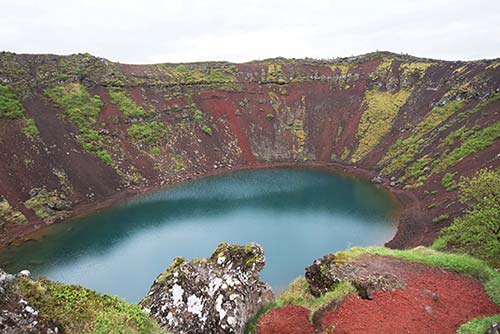
South Coast: All along the South Coast, you’ll see plenty of volcanoes—but you may not realize it, since they’re currently dormant and covered with thick glaciers. The most famous is Eyjafjallajökull, which blew its top in 2010. Several other large glaciers, such as Mýrdalsjökull and Vatnajökull, have volcanoes underneath. For a hike with the best possible views of glacier-topped volcanoes, head to Þórsmörk (see the South Coast chapter), where a huff up to the Valahnúkur viewpoint affords you panoramas over three different volcanoes.
Iceland’s best explanation of volcanic activity is at the Volcano Museum in the Westman Islands (see here). On the South Coast, the high-tech Lava Centre in Hvolsvöllur is both entertaining and educational (see here). A short drive up the road is the much more modest Iceland Erupts exhibit, which focuses on the 2010 Eyjafjallajökull eruption and its ashy impact. Reykjavík’s Volcano House shows films about the two most famous eruptions, and its Museum of Icelandic Natural Wonders (at the Pearl) is developing some volcano exhibits.
Iceland offers three opportunities to enter dormant volcanic caves. While quite expensive for what you get (especially the first option), they’re worthwhile for those interested in an up-close look.
Þríhnjúkagígur (a.k.a. “Inside the Volcano”; just southeast of Reykjavík, in the Bláfjöll mountains) offers the chance to descend into the magma chamber of a volcano that erupted about 4,000 years ago. The magma drained out and left a cavity so big that it could contain the Statue of Liberty. The first explorer entered in 1972. Now an elevator is rigged up in the opening every summer, allowing tourists to descend 400 feet into the bottle-shaped chamber, with a floor measuring 160 by 220 feet (the size of three basketball courts). The trip package includes hotel pickup in Reykjavík, the 30-minute bus ride out, a fairly easy 45-minute hike each way from the road to the volcano, the elevator down (5 minutes each way), 30 minutes on the floor of the chamber, and an included lunch. The rock is entirely cool—there’s no volcanic activity here anymore. At around $400, it’s not cheap, but it’s definitely memorable. Book in advance online (42,000 ISK, tours run mid-May-mid-Oct only, tel. 519-5609, www.insidethevolcano.com).
Raufarhólshellir (a.k.a. “The Lava Tunnel”) is an approximately mile-long, underground lava tube created when a flowing river of molten rock was enclosed, then drained out, leaving behind colorful formations. It’s about a 45-minute drive from downtown Reykjavík, roughly on the way to the South Coast. In 2017, the cave was closed to the public and converted into a private attraction—infuriating local spelunkers. Expect uneven footing and chilly temperatures; they’ll loan you coveralls and a helmet (6,400 ISK for basic one-hour tour, 9,900 ISK includes Reykjavík bus transfer; 19,900 ISK “extreme” tour lasts 3-4 hours, is more physically demanding, goes deeper into the tunnel, and includes Reykjavík transfer; prebooking required, www.thelavatunnel.is).
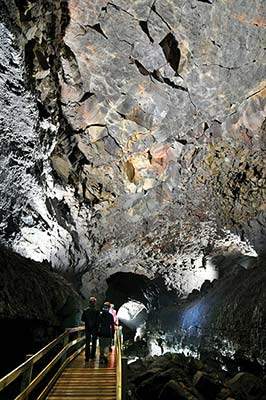
In West Iceland is the similar Víðgelmir (a.k.a. “The Cave”). This cave is newer (about 1,000 years old rather than 5,000) and more extensive, but also more remote (about a 2-hour drive north of Reykjavík, or an hour east of Borgarnes). With a guide, you can walk about a half-mile into a lava tube (for details, see the West Iceland chapter).
Iceland’s volcanic activity goes hand-in-hand with naturally heated water—which Icelanders have cleverly harnessed in a number of ways, from thermal baths to sources of electricity and heat.
Iceland has a wide range of options for enjoying its relaxing (and, yes, slightly stinky) thermal waters. Some bathing experiences cater primarily to tourists, chief among them the heavily advertised “premium baths.” The most famous of these is the Blue Lagoon near Keflavík Airport (see the Blue Lagoon & Reykjanes Peninsula chapter), but a similar (if smaller) version is Mývatn Nature Baths in North Iceland—a must for those doing the Ring Road. A less impressive premium bath is Fontana, in Laugarvatn and handy to the Golden Circle route. A new facility called Krauma has opened at Deildartunguhver in West Iceland. Other tourist-oriented bathing experiences include the Secret Lagoon, a simple but cleverly marketed bath a short drive from the Golden Circle route at Flúðir.
While those baths have big marketing budgets and attract lots of international visitors, they’re rarely frequented by Icelanders—who know that you can bathe in equally luxuriant 100°F water for a fraction of the price, albeit in simpler surroundings, at one of the country’s many thermal swimming pools (sundlaug). Every community of even a few hundred people seems to have scraped together the funds for their own well-maintained pool complex, often with a (warm) lap pool and at least one or two smaller hot pools (called “hot pots”). Many have a wide variety of different pools, saunas and steam rooms, and colorful waterslides for kids. In addition to being affordable, these provide a pleasantly authentic Icelandic experience, allowing you to rub elbows with locals who come home from work or school, grab a towel, and head to the pool. I’ve listed several of these in the Reykjavík area, and throughout the country—including in Borg, right along the Golden Circle; in a remote corner of West Iceland, at Húsafell; in tiny Hofsós, just off the Ring Road, with an infinity pool overlooking a fjord; and in Iceland’s second city, Akureyri.
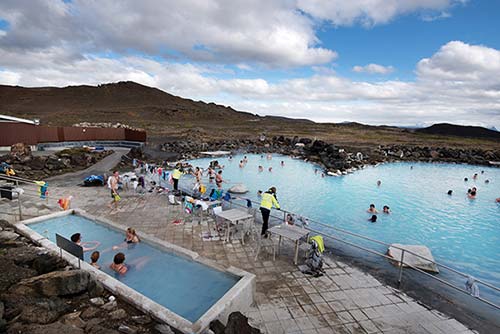
Up-to-date opening hours for each pool are on the website of each town, but you usually have to hunt for them a bit amidst the other municipal services. These websites also won’t show temporary closures (for special events, maintenance, etc.), so it’s wise to confirm opening hours by telephone before making a trek to a distant pool.
Various websites list Iceland’s thermal pools (try www.swimminginiceland.is or www.hotpoticeland.com). The free booklets Áning—Accommodation in Iceland and Thermal Bliss include extensive lists of pools (available at the Reykjavík TI or downloadable at www.icelandreview.com/publications). The Reykjavík Grapevine has a great article called “Every Swimming Pool in the Greater Reykjavík Area, Rated” (easily found at www.grapevine.is). Or you can simply keep a look¬out for the international “pool” symbol—a swimmer’s head poking out above waves—anywhere you go. Even though the clientele is mostly Icelandic, visitors are welcome (just follow the rules—see sidebar).

Finally, Iceland has a few opportunities to (carefully) bathe in natural thermal springs. Above the town of Hveragerði, near the end of the Golden Circle route, you can hike an hour to soak in the thermal river of Reykjadalur (see here). In the Highlands, Landmannalaugar (“The People’s Pools”) has a famous natural thermal area, which takes quite some effort to reach (only with an off-road vehicle, and only in summer); this is best done on a guided excursion (about 20,000 ISK, offered by many companies mid-June-mid-Sept, includes pick-up and drop-off in Reykjavík). It’s important to note that tourists routinely wind up in the burn unit of Reykjavík’s hospital after being scalded at natural thermal areas. Watch your step, keep on marked trails, bathe only where you see others doing so safely, and remember that a thermal landscape comes with lots of hidden dangers.
Wandering through a steaming, bubbling, colorful, otherworldly thermal landscape is a uniquely Icelandic treat. For such a small island, Iceland has a remarkable variety of these locations. Just watch your step—always stay on marked trails, as a thin crust can cover a boiling-hot reservoir—and be ready for some intense sulfur smells.

The most visited is Geysir, on the Golden Circle. But, while it’s unique in offering the chance to watch a geyser spurt high into the air, it’s crowded. For more interesting and varied thermal landscapes, consider the following options.
Perhaps the best thermal area is at Námafjall, just over the hills from Mývatn, in North Iceland. Much closer to Reykjavík, the Seltún geothermal area on the Reykjanes Peninsula is quite striking. “Honorable mentions” go to the sputtering shore of Laugarvatn lake, along the Golden Circle route; the bubbling spring at Deildartunguhver, in West Iceland; and the steaming valley of Reykjadalur, above the town of Hveragerði (just off the Golden Circle route). See “Thermal Bath Hikes,” later.
To see how Iceland has harnessed the substantial power of its thermal waters, stop by a geothermal plant. Hellisheiðarvirkjun sits amidst a lunar landscape just outside Reykjavík, on the way to the Golden Circle and South Coast day trips, and boasts Iceland’s most extensive visitors center about its geothermal energy industry. Krafla, with a modest information center, fills a dramatic valley in the north, near Mývatn.
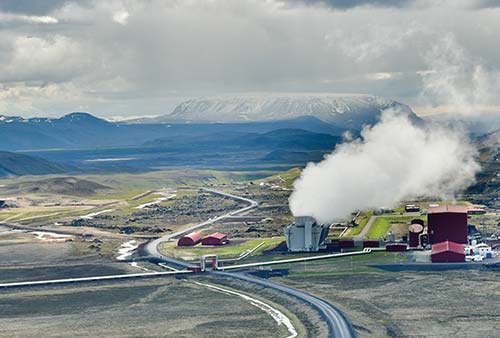
Many come to Iceland hoping to catch a glimpse of the elusive whales of the North Atlantic. The waters here are home to 23 different varieties of gentle giants. On a typical whale-watching trip, you’re most likely to see white-beaked dolphins, harbor porpoises, and mid-sized minke whales (the species also listed on local menus). If you have luck, you may spot a breaching humpback whale (most often seen from ports in North Iceland, such as Húsavík and Akureyri) or a black-and-white orca (Keiko, the killer whale of Free Willy fame, was captured in Iceland). On very rare occasions, some get a glimpse of one of the two biggest mammals on the planet: the blue whale or the fin whale.
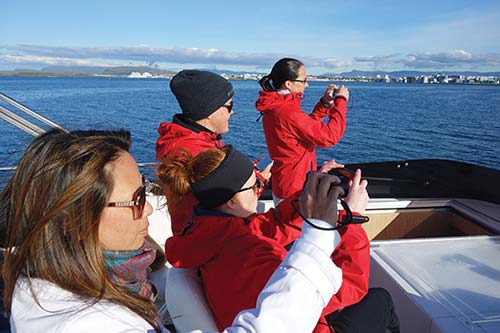
Several companies offer whale-watching boat trips (generally 3-4 hours for about 11,000 ISK). These once were concentrated in North Iceland: in the tiny town of Húsavík, and Iceland’s second city of Akureyri (see listings for both in the Ring Road chapter). The same trips (and many of the same companies) are now also well-established in Reykjavík, making it easier to whale watch without a long trek north. See the Reykjavík chapter for a rundown of your options.
Ideally, don’t book your whale-watching trip too far in advance. Follow the weather report and choose a summer day that’s as sunny and windless as possible; like you, whales and dolphins enjoy nice weather and are most likely to surface then. May through August are the best months, when whales are attracted to the small creatures feeding near the sun-warmed surface of the water. Windy weather or rough seas can turn the trip into four hours of seasickness, and you likely won’t see more than a dolphin or two. From November to February, I’d skip the trip entirely. Dress warmly (though boat operators usually have extra outerwear to loan).
Be aware that whale-watching trips are a big commitment of time and money—best for those with a serious interest in the creatures. For a guaranteed, up-close look at (artificial) whales, stop by the expensive but enjoyable Whales of Iceland exhibit near Reykjavík’s harbor.
Adorable, chubby little puffins—with their black-and-white markings and cartoonish beaks—are fun to watch. They usually arrive in Iceland in early summer, then take off again at summer’s end—making the window for seeing them quite short. (For more on puffins, see the sidebar on the next page.)
The biggest puffin populations are in the Westman Islands (with about half of Iceland’s estimated 10 million puffins—and one-fifth of the world’s puffins); along the South Coast (particularly around the Dyrhólaey promontory, and farther east, at Ingólfshöfði cape); and along the Westfjords (at Látrabjarg, Hornbjarg, Hornstrandir, and Breiðafjörður). The islet called Lundey (“Puffin Island”)—with a relatively small population of about 20,000 puffins—is ideally situated just a short boat trip from downtown Reykjavík, and a handy destination for a puffin cruise from the Old Harbor. Perhaps Iceland’s best puffin experience is at the Westman Islands’ Sæheimar Aquarium, where you can usually meet a real-life puffin named Tóti, who was rescued as a stranded puffling by local kids.
Birders find plenty of other seabird species to get excited about in Iceland. Along with puffins, the auk family includes the guillemot, the murre, and the razorbill (all of which have a black body and white belly, but lack that cute orange beak). Arctic terns are sleek flyers—gray on top, white on bottom, with a black crown and a reddish beak. They’re notorious for aggressively dive-bombing tourists who wander too close to their nests, then pulling up at the last second. Arctic terns have the longest migration in the animal kingdom: They spend their summers in the Arctic...and then, come fall, fly to the “southern summer” in the Antarctic (over its life, an Arctic tern might fly as many as 1.5 million miles). Rounding out the flock are seagull-like fulmars and kittiwakes. Iceland has several freshwater bird species as well, including ducks, oystercatchers, and golden plovers.
For a one-stop look at (taxidermy-style) examples of all Icelandic bird species, head north to Sigurgeir’s Bird Museum near Mývatn (see here).
Icelandic horses are small, strong, and docile, and descend from the ponies originally brought to Iceland in the Settlement Age. (Viking Age settlers carefully selected only the smallest yet strongest horses for the journey—able to fit on their ships, but capable of working hard once in Iceland.) Today, Icelandic horses are exported to enthusiasts worldwide, but since A.D. 982, no horses have been imported to the island—so every one you see is a purebred. Icelandic horses are renowned for their unique gaits: In addition to the typical walk, trot, and gallop, Icelandic horses employ the tölt, which is fast and extremely smooth, and the skeið, a high-speed “flying pace.” This “five-gaited” status is their claim to fame.
Even if you’re not an equestrian enthusiast, a horseback ride is a nice way to enjoy the outdoors for a couple of hours, much as Icelanders have for centuries. Horseback riding is big business, and dozens of farms all over Iceland offer rides for travelers—including a cluster just outside Reykjavík. Browse and book on company websites: Íslenski Hesturinn (The Icelandic Horse, tel. 434-7979, http://islenskihesturinn.is), Viking Horses (mobile 660-9590, www.vikinghorses.is), Laxnes (tel. 566-6179, www.laxnes.is), and Íshestar (tel. 555-7000, www.ishestar.is).
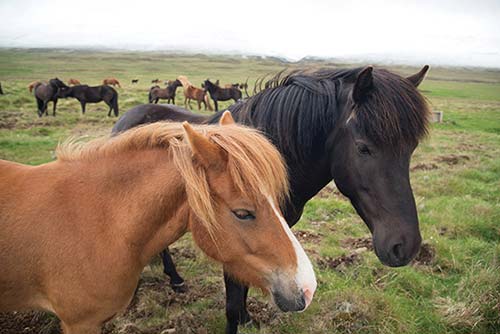
It’s usually a half-day affair, either morning or afternoon. If you’re based in Reykjavík, they’ll pick you up, drive you out to the farm, outfit you with a helmet and riding gear, give you about an hour and a half on horseback, and drop you off afterwards, all for about 12,000-15,000 ISK (some tours throw in lunch; Laxnes and Íshestar lower the price if you drive out yourself). Beyond the Reykjavík area, your scores of options include some in dramatic surroundings: in the broad valley of Skagafjörður, through the glacial rivulets of Þórsmörk, along the beaches of the South Coast, and so on. Wherever you ride, check the weather forecast before booking.
For just a glimpse of an Icelandic horse, watch for roadside paddocks all around the island. Or head to the Reykjavík Family Park and Zoo (see here), ideally at feeding time. On weekends, the zoo lets little kids trot around the horse paddock, accompanied by a keeper.
Iceland is a wonderland for hikers, whether you’re taking an easy stroll from your car to a waterfall, or embarking on a grueling but dramatic multiday trek. Before heading out on a challenging hike, make sure you have proper equipment, water, maps, and advice from an experienced local. Be aware of current weather conditions—and don’t underestimate the impact of Iceland’s howling winds and bone-chilling (even in summer) temperatures. Read “The Many Ways Iceland Can Kill You” sidebar (earlier in this chapter).
Throughout this book, I’ve focused on easy hikes that offer a big reward for minimal effort—mainly starting from a parking lot and looping through an accessible slice of Icelandic scenery. More details on each of these are given in the individual chapters. Some of my favorite, easy car hikes include the loop through Þingvellir along the Golden Circle route; the hikes up to the South Coast glaciers at Sólheimajökull and Skaftafell; the hike up to the lighthouse at Dyrhólaey promontory, on the South Coast; and walking up to Eldfell volcano on the Westman Islands. Along the Ring Road, there’s a variety of enjoyable options around Mývatn lake—including the pseudocraters at Skútustaðir, the forested peninsula at Höfði, and the lava pillars at Dimmuborgir. Other Mývatn hikes include the Námafjall thermal field and adjacent hill-climb just over the mountains from the lake, and the hike out to the volcanic cone at Leirhnjúkur. Also consider the crater hikes described in the “Volcanoes” section, earlier.
Each of the great waterfalls I’ve described in Iceland comes with a hike—some short, some long—and often an opportunity to climb up to a higher vantage point: Gullfoss on the Golden Circle, Seljalandsfoss (and its neighbor Gljúfrabúi) on the South Coast, Skógafoss on the South Coast, Hraunfossar and Barnafoss in West Iceland, and along the Ring Road—Goðafoss and Dettifoss in North Iceland, and Svartifoss in the southeast.
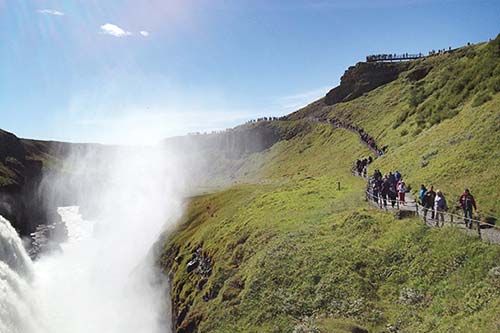
To combine a hike with a natural thermal bathing experience, you can walk about an hour up the valley called Reykjadalur, just above the town of Hveragerði (an hour from Reykjavík and on the route of both the Golden Circle and the South Coast day trips). Your reward is a thermal river where you can recline in warm, rushing water. Less of a hike, and less rewarding, is Seljavallalaug, a tepid pool tucked into the side of a mountain about a 15-minute hike from the South Coast road. At both, expect minimal, grubby changing areas and plenty of adventurous hikers.
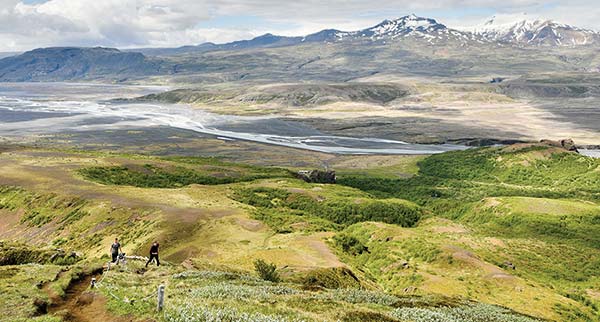
For serious hikers, Iceland offers dozens of premier hiking destinations—many in the Highlands, and inaccessible with a standard car. The two below are perhaps the best-known; for either you’ll need a high-clearance four-wheel drive vehicle, or you can ride in a specially equipped excursion bus.
Perhaps the best combination of quality hiking and accessibility is Þórsmörk, a volcanic landscape with glorious mountain, valley, and canyon walks; the moderately challenging hike up to Valahnúkur is spectacular. Þórsmörk is a short detour from the South Coast, but most people get there via excursion bus from Reykjavík (5 hours each way; for more on Þórsmörk, see the South Coast chapter).
More remote is Landmannalaugar, in the Highlands about 120 miles east of Reykjavík (much of it on difficult-to-traverse, gravel-and-rock roads; about 4.5 hours one-way, open only in summer). In this vivid area—striped with volcanic hues—a petrified lava field from 1477 butts up against pointy peaks, with excellent trails and some natural thermal pools. Hikes abound: You could trek to the crater lake called Ljótipollur (“Ugly Puddle”); huff your way up the extremely colorful Brennisteinsalda, with high-altitude views and an optional detour to the Stórihver thermal area near the top; or opt for an easier walk to the big lake called Frostastaðavatn.
To reach Landmannalaugar, you’ll need a 4x4 vehicle, or you can join an excursion (typically Aug-Sept, starting at 20,000 ISK, offered by various outfits). You can also take a bus operated by Iceland On Your Own (www.ioyo.is), Trex (www.trex.is), or Iceland By Bus (www.icelandbybus.is). While you can get a glimpse of the area in a very long day trip from Reykjavík, serious hikers overnight at the Landmannalaugar hut/campground.
Both Þórsmörk and Landmannalaugar are key stops along a variety of popular multiday hikes (with overnights in staffed huts) that traverse the glacial landscape of the south. One of the most popular routes, called Laugavegur, takes three to five days (34 miles over challenging terrain) and connects Þórsmörk and Landmannalaugar. Another favorite is the two-day, 14-mile Fimmvörðuháls hike, from Þórsmörk south, over the saddle between Eyjafjallajökull and Mýrdalsjökull, to Skógar on the South Coast—right over the site of the first stage of the 2010 Eyjafjallajökull eruption.
For something closer to the capital, you could ascend Esja—the big, long ridge that looms just north of Reykjavík. The most popular hike here is the four-mile round-trip to Steinn (“The Stone”), with an elevation gain of 650 feet (don’t attempt this in cold weather).
For details on these, and good overall information about hiking, see the websites of FÍ (the Iceland Touring Association, www.fi.is) and NAT (Nordic Adventure Travel, www.nat.is). Companies offering guided hikes in Iceland include Icelandic Mountain Guides (www.mountainguides.is) and Trek Iceland (www.trek.is).
To reach spectacular scenery without the climb, you can choose from a variety of wheeled tours. Tours by mountain bike, by ATV, or by “Super Jeep” (a monster 4x4 vehicle that can go just about anywhere) give you access to some of the more remote areas mentioned earlier.
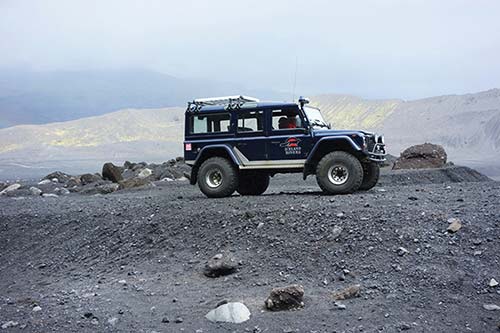
Various companies also offer rafting and kayaking tours, either in the canyon just below Gullfoss (the thundering waterfall on the Golden Circle), or in North Iceland on two rivers that drain the Hofsjökull glacier, south of Sauðárkrókur in the Skagafjörður region. Companies include Arctic Rafting (www.arcticrafting.com) and Viking Rafting (www.vikingrafting.is).
For divers, scuba diving or snorkeling at Silfra—a fissure flooded with crystal-clear glacial water, at Þingvellir on the Golden Circle—is a highlight (see the Golden Circle chapter).
The northern lights are a magical, occasional, serendipitous sight on clear, crisp nights in Iceland from about the end of August to the middle of April. You can’t really plan to see the northern lights—they don’t always appear, and when they do, are often obscured by cloud cover. While often visible in Reykjavík, the northern lights stand out better farther from the center of town and in the countryside, where there’s less light pollution. All things being equal, spending a night or two in a more remote area could increase your chances.
The dreamy northern lights images that you see are done using long exposures and sometimes Photoshop (tweaking the aurora colors to a Kermit-the-Frog green). What you’ll actually see will probably be closer to the color of a Thai green curry—more coconut milk than Kermit.
With all the interesting things to do in Iceland, it would be a shame to spend your energy chasing after the northern lights every evening. I suggest planning your trip as if you won’t see them, and considering it as a bonus if you do. Whether you’ll see the lights or not is mostly out of your control, but consider the tips below to improve your odds.
Come during aurora season. Visit Iceland in aurora season (from a little before the fall equinox to a little after the spring equinox). Some say that September/October and February/March are the best months. At the least, they have longer days and nicer temperatures, so you can enjoy regular sightseeing more. If you’re planning to rent a car, go in fall, when the road conditions are better.
Maximize your chances. It’s easy to miss the northern lights simply by not bothering to look for them.
On any clear, dark night, go outside and scan the sky every half hour or so up until bedtime. You can follow the aurora and cloud-cover forecast on the Icelandic weather service’s English-language website (http://en.vedur.is; click on “Weather,” then “Aurora forecasts”). The American aurora forecasts at www.swpc.noaa.gov also cover Iceland.
See the lights without a car. If you’re staying in Reykjavík and you don’t have a car, consider taking a northern lights bus tour (around 7,000 ISK). Tours only run when conditions look good—call around dinnertime to find out. You’ll leave town at 21:00 or 22:00 and you won’t be in bed until almost four hours later. Read a few reviews before you go, and remember that even if the forecast is good, you may see nothing at all. (If so, the bus company will likely give you a voucher for another trip—not much help on a short visit.) For some, the trip is a nice chance to snuggle up with a travel partner on a bus and listen to an entertaining tour guide who serves hot cocoa. For others, it’s a disappointing few hours of yawning and wishing they’d turned in early.
See the lights with a car. If you’re staying in Reykjavík and have a car, you could put together your own northern lights tour by driving out into the suburbs or a little way into the countryside. Þingvellir (see the Golden Circle chapter) and Kleifarvatn (see the Blue Lagoon & Reykjanes Peninsula chapter) are plenty dark and within a 45-minute drive of town. If you stay within greater Reykjavík, drive out toward the tips of Seltjarnarnes or Álftanes (by Bessastaðir, the presidential residence), where city lights are a little dimmer.